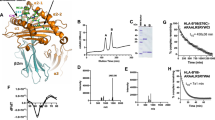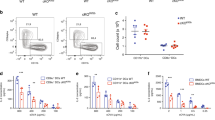Abstract
The ability of killer T cells carrying the CD8 antigen to detect tumours or intracellular pathogens requires an extensive display of antigenic peptides by major histocompatibility complex (MHC) class I molecules on the surface of potential target cells1. These peptides are derived from almost all intracellular proteins and reveal the presence of foreign pathogens and mutations. How cells produce thousands of distinct peptides cleaved to the precise lengths required for binding different MHC class I molecules remains unknown2,3. The peptides are cleaved from endogenously synthesized proteins by the proteasome in the cytoplasm4,5 and then trimmed by an unknown aminopeptidase in the endoplasmic reticulum (ER)6,7,8. Here we identify ERAAP, the aminopeptidase associated with antigen processing in the ER. ERAAP has a broad substrate specificity, and its expression is strongly upregulated by interferon-γ. Reducing the expression of ERAAP through RNA interference prevents the trimming of peptides for MHC class I molecules in the ER and greatly reduces the expression of MHC class I molecules on the cell surface. Thus, ERAAP is the missing link between the products of cytosolic processing and the final peptides presented by MHC class I molecules on the cell surface.
This is a preview of subscription content, access via your institution
Access options
Subscribe to this journal
Receive 51 print issues and online access
$199.00 per year
only $3.90 per issue
Buy this article
- Purchase on SpringerLink
- Instant access to full article PDF
Prices may be subject to local taxes which are calculated during checkout




Similar content being viewed by others
References
Shastri, N., Schwab, S. & Serwold, T. Producing nature's gene-chips. The generation of peptides for display by MHC class I molecules. Annu. Rev. Immunol. 20, 463–493 (2002)
Falk, K., Rötzschke, O. & Rammensee, H. G. Cellular peptide composition governed by major histocompatibility complex class I molecules. Nature 348, 248–251 (1990)
Falk, K., Rotzschke, O., Stevanovic, S., Jung, G. & Rammensee, H.-G. Allele-specific motifs revealed by sequencing of self-peptides eluted from MHC molecules. Nature 351, 290–296 (1991)
Rock, K. L. & Goldberg, A. L. Degradation of cell proteins and the generation of MHC class I-presented peptides. Annu. Rev. Immunol. 17, 739–779 (1999)
Kloetzel, P.-M. Antigen processing by the proteasome. Nature Rev. Mol. Cell Biol. 2, 179–187 (2001)
Serwold, T., Gaw, S. & Shastri, N. ER aminopeptidases generate a unique pool of peptides for MHC class I molecules. Nature Immunol. 2, 644–651 (2001)
Brouwenstijn, N., Serwold, T. & Shastri, N. MHC class I molecules can direct proteolytic cleavage of antigenic precursors in the endoplasmic reticulum. Immunity 15, 95–104 (2001)
Fruci, D., Niedermann, G., Butler, R. H. & van Endert, P. M. Efficient MHC Class I-independent amino-terminal trimming of epitope precursor peptides in the endoplasmic reticulum. Immunity 15, 467–476 (2001)
Hellman, U., Wernstedt, C., Gonez, J. & Heldin, C. H. Improvement of an ‘In-Gel’ digestion procedure for the micropreparation of internal protein fragments for amino acid sequencing. Anal. Biochem. 224, 451–455 (1995)
Clauser, K. R., Baker, P. & Burlingame, A. L. Role of accurate mass measurement (± 10 ppm) in protein identification strategies employing MS or MS/MS and database searching. Anal. Chem. 71, 2871–2882 (1999)
Helen, I. & Field, E. D. RADARS, a bioinformatics solution that automates proteome mass spectral analysis, optimises protein identification, and archives data in a relational database. Proteomics 2, 36–47 (2001)
Hattori, A., Matsumoto, H., Mizutani, S. & Tsujimoto, M. Molecular cloning of adipocyte-derived leucine aminopeptidase highly related to placental leucine aminopeptidase/oxytocinase. J. Biochem. (Tokyo) 125, 931–938 (1999)
Medzihradszky, K. F. et al. The characteristics of peptide collision-induced dissociation using a high-performance MALDI-TOF/TOF tandem mass spectrometer. Anal. Chem. 72, 552–558 (2000)
Schomburg, L., Kollmus, H., Friedrichsen, S. & Bauer, K. Molecular characterization of a puromycin-insensitive leucyl-specific aminopeptidase, PILS-AP. Eur. J. Biochem. 267, 3198–3207 (2000)
Miyashita, H. et al. A mouse orthologue of puromycin-insensitive leucyl-specific aminopeptidase is expressed in endothelial cells and plays an important role in angiogenesis. Blood 99, 3241–3249 (2002)
Rawlings, N. D., O'Brien, E. A. & Barrett, A. J. MEROPS: the protease database. Nucleic Acids Res. 30, 343–346 (2002)
Boehm, U., Klamp, T., Groot, M. & Howard, J. C. Cellular responses to interferon-γ. Annu. Rev. Immunol. 15, 749–795 (1997)
Elbashir, S. M. et al. Duplexes of 21-nucleotide RNAs mediate RNA interference in cultured mammalian cells. Nature 411, 494–498 (2001)
Fehling, H. J. et al. MHC class I expression in mice lacking the proteasome subunit LMP-7. Science 265, 1234–1237 (1994)
Preckel, T. et al. Impaired immunoproteasome assembly and immune responses in PA28-/- mice. Science 286, 2162–2165 (1999)
Anderson, K. et al. Endogenously synthesized peptide with an endoplasmic reticulum signal sequence sensitizes antigen processing mutant cells to class I-restricted cell-mediated lysis. J. Exp. Med. 174, 489–492 (1991)
Paz, P., Brouwenstijn, N., Perry, R. & Shastri, N. Discrete proteolytic intermediates in the MHC class I antigen processing pathway and MHC I-dependent peptide trimming in the ER. Immunity 11, 241–251 (1999)
Shastri, N. & Gonzalez, F. Endogenous generation and presentation of the OVA peptide/Kb complex to T-cells. J. Immunol. 150, 2724–2736 (1993)
Cascio, P., Hilton, C., Kisselev, A. F., Rock, K. L. & Goldberg, A. L. 26S proteasomes and immunoproteasomes produce mainly N-extended versions of an antigenic peptide. EMBO J. V20, 2357–2366 (2001)
Toes, R. E. M. et al. Discrete cleavage motifs of constitutive and immunoproteasomes revealed by quantitative analysis of cleavage products. J. Exp. Med. 194, 1–12 (2001)
Egen, J. G. & Allison, J. P. Cytotoxic T lymphocyte antigen-4 accumulation in the immunological synapse is regulated by TCR signal strength. Immunity 16, 23–35 (2002)
Acknowledgements
We thank J. Egen for help with fluorescence microscopy; D. King for peptide synthesis; and S. Schwab for comments. This work was supported by grants to N.S. from the NIH.
Author information
Authors and Affiliations
Corresponding author
Ethics declarations
Competing interests
The authors declare that they have no competing financial interests.
Rights and permissions
About this article
Cite this article
Serwold, T., Gonzalez, F., Kim, J. et al. ERAAP customizes peptides for MHC class I molecules in the endoplasmic reticulum. Nature 419, 480–483 (2002). https://doi.org/10.1038/nature01074
Received:
Accepted:
Issue Date:
DOI: https://doi.org/10.1038/nature01074



